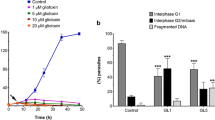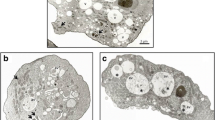Abstract
Tritrichomonas foetus is an amitochondriate parasite that possesses hydrogenosomes, unusual anerobic energy-producing organelles. In these organisms the “mitochondrial cell death machinery” is supposed to be absent, and the mechanisms that lead to cell demise remain to be elucidated. The presence of a cell death program in trichomonads has already been reported, suggesting the existence of a caspase-like execution pathway in such organisms. Here we demonstrate the alterations provoked by the fungicide griseofulvin and raise the possibility that other cell death pathways may exist in T. foetus. Dramatic changes in trichomonads morphology are presented after griseofulvin treatment, such as intense plasma membrane and nuclear envelope blebbing, nucleus fragmentation, and an abnormal number of oversized vacuoles. One important finding was the exposition of phosphatidylserine (PS) in the outer leaflet of the plasma membrane in cells after drug treatment, and also the presence of a high amount of misshapen flagella and tubulin precipitates as vacuolar contents, suggesting an autophagic process of abnormal cellular elements. Interestingly, immunoreactivity for activated caspase-3 was not detected during griseofulvin treatment, a finding distinct from the observed when this cell was treated with H2O2. The possibility of the existence of different pathways to cell death in trichomonads is discussed.












Similar content being viewed by others
Abbreviations
- DMSO:
-
Dimethyl sulfoxide
- DAPI:
-
4′,6-diamidino-2-phenylindole dihydrochloride
- AIF:
-
Apoptosis-inducing factor
- CAD:
-
Caspase-activated DNase
References
Arnoult D, Tatischeff I, Estaquier J, Girard M, Sureau F, Tissier JP, Grodet A, Dellinger M, Traincard F, Kahn A, Ameisen JC, Petit PX, (2001) On the evolutionary conservation of the cell death pathway: mitochondrial release of an apoptosis-inducing factor during Dictyostelium discoideum cell death. Mol Biol Cell 12:3016–3030
Arnoult D, Akarid K, Grodet A, Petit PX, Estaquier J, Ameisen JC (2002) On the evolution of programmed cell death: apoptosis of the unicellular eukaryote Leishmania major involves cysteine proteinase activation and mitochondrion permeabilization. Cell Death Differ 9:65–81
Benchimol M (1999) Hydrogenosome autophagy: an ultrastructural and cytochemical study. Biol Cell 91:165–174
Benchimol M (2001) Hydrogenosome morphological variation induced by fibronectin and other drugs in Trichomonas vaginalis and Tritrichomonas foetus. Parasitol Res 87:215–222
Bera A, Singh S, Nagaraj R, Vaidya T (2003) Induction of autophagic cell death in Leishmania donovani by antimicrobial peptides. Mol Biochem Parasitol 127:23–35
Chang HY, Yang X (2000) Proteases for cell suicide: functions and regulation of caspases. Microbiol Mol Biol Rev 64:821–846
Chose O, Noel C, Gerbod D, Brenner C, Viscogliosi E, Roseto A (2002) A form of cell death with some features resembling apoptosis in the amitochondrial unicellular organism Trichomonas vaginalis. Exp Cell Res 276:32–39
Christensen ST, Chemnitz J, Straarup EM, Kristiansen K, Wheatley DN, Rasmussen L (1998) Staurosporine-induced cell death in Tetrahymena thermophila has mixed characteristics of both apoptotic and autophagic degeneration. Cell Biol Int 22:591–598
Cohen GM (1997) Caspases: the executioners of apoptosis. Biochem J 326:1–16
Deshmukh M, Johnson EM Jr (1998) Evidence of a novel event during neuronal death: development of competence-to-die in response to cytoplasmic cytochrome c. Neuron 21:695–705
Develoux M (2001) Griseofulvin. Ann Dermatol Venereol 128:1317–1325
Diamond LS (1957) The establishment of various trichomonads of animals and man in axenic cultures. J Parasitol 43:488–490
Dunn WA Jr (1990) Studies on the mechanisms of autophagy: formation of the autophagic vacuole. J Cell Biol 110:1923–1933
Gordon MB, Howard L, Compton DA (2001) Chromosome movement in mitosis requires microtubule anchorage at spindle poles. J Cell Biol 152:425–434
Granger BL, Warwood SJ, Benchimol M, de Souza W (2000) Transient invagination of flagella by Tritrichomonas foetus. Parasitol Res 86:699–709
Guimarães CA, Benchimol M, Amarante-Mendes GP, Linden R (2003) Alternative programs of cell death in developing retinal tissue. J Biol Chem 278:41938–41946
Huettenbrenner S, Maier S, Leisser C, Polgar D, Strasser S, Grusch M, Krupitza G (2003) The evolution of cell death programs as prerequisites of multicellularity. Mutat Res 543:235–249
Jia L, Dourmashkin RR, Allen PD, Gray AB, Newland AC, Kelsey SM (1997) Inhibition of autophagy abrogates tumor necrosis factor alpha induced apoptosis in human T-lymphoblastic leukemia cells. Br J Haematol 98:673–685
Lee N, Bertholet S, Debrabant A, Muller J, Duncan R, Nakhasi HL (2002) Programmed cell death in the unicellular protozoan parasite Leishmania. Cell Death Differ 9:53–64
Lloyd D, Harris JC, Maroulis S, Biagini GA, Wadley RB, Turner MP, Edwards MR (2000) The microaerophilic flagellate Giardia intestinalis: oxygen and its reaction products collapse membrane potential and cause cytotoxicity. Microbiology 146:3109–3118
Madeiro da Costa RF, Benchimol M (2004) The effect of drugs on cell structure of Tritrichomonas foetus. Parasitol Res 92:159–170
Mariante RM, Guimarães CA, Linden R, Benchimol M (2003) Hydrogen peroxide induces caspase activation and programmed cell death in the amitochondrial Tritrichomonas foetus. Histochem Cell Biol 120:129–141
Moreira ME, Barcinski MA (2004) Apoptotic cell and phagocyte interplay: recognition and consequences in different cell systems. Acad Bras Ciênc 76:93–115
Muller M (1993) The hydrogenosome. J Gen Microbiol 139:2879–2889
Muller M (1990) Structure. In: Honigberg BM (eds) Trichomonads parasitic in humans. Springer, Berlin Heidelberg New York, pp 5–35
Namura S, Zhu J, Fink K, Endres M, Srinivasan A, Tomaselli KJ, Yuan J, Moskowitz MA (1998) Activation and cleavage of caspase-3 in apoptosis induced by experimental cerebral ischemia. J Neurosci 18:3659–3668
Noël C, Gerbod D, Delgado-Viscogliosi P, Fast NM, Ben Younes A, Chose O, Roseto A, Capron M, Viscogliosi E (2003) Morphogenesis during division and griseofulvin-induced changes of the microtubular cytoskeleton in the parasitic protist, Trichomonas vaginalis. Parasitol Res 89:487–494
Pereira-Neves A, Ribeiro KC, Benchimol M (2003) Pseudocysts in trichomonads—new insights. Protist 154:313–329
Ravagnan L, Roumier T, Kroemer G (2002) Mitochondria, the killer organelles and their weapons. J Cell Physiol 192:131–137
Ribeiro KC, Monteiro-Leal LH, Benchimol M (2000) Contributions of the axostyle and flagella to closed mitosis in the protists Tritrichomonas foetus and Trichomonas vaginalis. J Eukaryot Microbiol 47:481–492
Ribeiro KC, Arnholdt AC, Benchimol M (2002) Tritrichomonas foetus: induced division synchrony by hydroxyurea. Parasitol Res 88:627–631
Rubino S, Unger E, Fogu G, Cappuccinelli P (1982) Effect of microtubule inhibitors in the tubulin system of Dictyostelium discoideum. Z Allg Mikrobiol 22:127–131
Savill J, Fadok V (2000) Corpse clearance defines the meaning of cell death. Nature 407:784–788
Seglen PO, Gordon PB (1982) 3-Methyladedine: specific inhibitor of autophagic/lysosomal protein degradation in isolated rat hepatocytes. Proc Natl Acad Sci USA 79:1889–1892
Sen N, Das BB, Ganguly A, Mukherjee T, Tripathi G, Bandyopadhyay S, Rakshit S, Sen T, Majumder HK (2004) Camptothecin induced mitochondrial dysfunction leading to programmed cell death in unicellular hemoflagellate Leishmania donovani. Cell Death Differ 11:924–936
Sparagano OA (1995) Griseofulvin: generation time and ATP changes in the ciliate Tetrahymena pyriformis. Life Sci 57:897–901
Sperandio S, de Belle I, Bredesen DE (2000) An alternative, no apoptotic form of programmed cell death. Proc Natl Acad Sci USA 97:14376–14381
Stennicke HR, Salvesen GS (2000) Caspases—controlling intracellular signals by protease zymogene activation. Biochim Biophys Acta 1477:299–306
van Loo G, Saelens X, van Gurp M, MacFarlane M, Martin SJ, Vandenabeele P (2002) The role of mitochondrial factors in apoptosis: a Russian roulette with more than one bullet. Cell Death Differ 9:1031–1042
Wyllie AH (1981) Cell death: a new classification separating apoptosis from necrosis. In: Bowen ID, Lockshin RA (eds) Cell death in biology and pathology. Chapman and Hall, New York, pp 9–34
Wyllie AH, Goldstein P (2001) More than one way to go. Proc Natl Acad Sci USA 98:11–13
Acknowledgements
This work was supported by Conselho Nacional de Desenvolvimento Científico e Tecnológico (CNPq), Programa de Apoio a Núcleos de Excelência (PRONEX), Fundação Carlos Chagas Filho de Amparo à Pesquisa do Estado do Rio de Janeiro (FAPERJ), Coordenação de Aperfeiçoamento de Pessoal de Nível Superior (CAPES), and Associação Universitária Santa Úrsula (AUSU). The authors thank Dr. Keith Gull for the TAT-1 antibody and Dr. Anu Srinivasan for the CM1 antibody.
Author information
Authors and Affiliations
Corresponding author
Rights and permissions
About this article
Cite this article
Mariante, R.M., Vancini, R.G. & Benchimol, M. Cell death in trichomonads: new insights. Histochem Cell Biol 125, 545–556 (2006). https://doi.org/10.1007/s00418-005-0098-5
Accepted:
Published:
Issue Date:
DOI: https://doi.org/10.1007/s00418-005-0098-5




